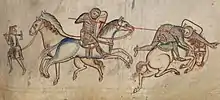Richard Marshal, 3rd Earl of Pembroke
Richard Marshal, 3rd Earl of Pembroke (1191 – 16 April 1234), was the son of William Marshal, 1st Earl of Pembroke and brother of William Marshal, 2nd Earl of Pembroke, whom he succeeded to the Earldom of Pembroke and Lord Marshal of England upon his brother's death on 6 April 1231.
The Earl of Pembroke | |
|---|---|
| Born | 1191 |
| Died | 16 April 1234 (aged 43) Kilkenny Castle, Ireland |
| Allegiance | |
| Battles/wars | Battle of Monmouth (1233) Battle of the Curragh |
Life
Richard Marshal held lands in Longueville, Normandy; in Wales; and also in Ireland.

He came to the fore as the leader of the baronial party, and the chief antagonist of the foreign friends of King Henry III of England,[1] a notable Poitevin, Peter des Roches, Bishop of Winchester and Peter de Rivaux.[2] Fearing their treachery, he refused to visit King Henry III at Gloucester in August 1233, and he was declared a traitor.[1] According to the chronicler Roger of Wendover in his Flores Historiarum (Flowers of History), Marshal and his knights then came to Monmouth to reconnoitre the town before besieging it. However, they were seen coming towards the castle walls by Baldwin III, Count of Guînes. He was a nobleman of Flanders who, with his mixed force of Flemings and Poitevins, had been entrusted by King Henry with defending the town. The local lord, John of Monmouth, was absent from the battle.[3] Baldwin wrongly thought that Marshal had only a few followers with him, and rode out with his forces to pursue him, but Marshal turned the tables. It was said of Marshal that he put up a gallant defense against Baldwin's men in this skirmish and his army defeated Baldwin's forces at the Battle of Monmouth (1233) on 25 November.[4] In March 1234, a truce was reached between the king and Marshal, the condition of which was the removal of Peter de Rivaux from court.[5] In the meanwhile, however, conflict had broken out in Ireland between Marshal's brothers and some of the king's supporters.
Hostilities followed, and Richard made an alliance with the Welsh prince Llywelyn the Great. Pembroke crossed from Wales to Ireland, where Peter des Roches had allegedly instigated his enemies to attack.[1] In April 1234 he was overpowered and wounded at the Battle of the Curragh by forces led by Maurice FitzGerald, Justiciar of Ireland and died of his wounds on 16 April 1234 while being held prisoner.[6] Marshal's popularity also meant that his death was mourned in England, while the Poitevins—who were rumoured to have instigated the Irish war—fell further into disregard.[7]
He had married Gervaise de Dinan, daughter of Alan de Dinan, Baron de Dinan, and did not produce any offspring. He was buried at Kilkenny and was succeeded by his brother Gilbert.
Notes
-
 One or more of the preceding sentences incorporates text from a publication now in the public domain: Chisholm, Hugh, ed. (1911). "Pembroke, Earls of s.v. Richard Marshal". Encyclopædia Britannica. 21 (11th ed.). Cambridge University Press. p. 78.
One or more of the preceding sentences incorporates text from a publication now in the public domain: Chisholm, Hugh, ed. (1911). "Pembroke, Earls of s.v. Richard Marshal". Encyclopædia Britannica. 21 (11th ed.). Cambridge University Press. p. 78. - Powicke (1962), pp. 53–5.
- Kissack, Keith (1974). Mediaeval Monmouth. The Monmouth Historical and Educational Trust. p. 25.
- Roger of Wendover, Flowers of History: the history of England from the descent of the Saxons to A.D. 1235. vol.2, pp.575-576.
- Power (2004).
- Frame, p.367.
- Powicke (1962), pp.57–9.
References
- Frame, Robin (2007). Oxford Companion to Irish History. Oxford: Oxford University Press. ISBN 978-0-19-923483-7.
- Power, D. J. (2004). "Marshal, Richard, sixth earl of Pembroke (d. 1234)". Oxford Dictionary of National Biography. Oxford: Oxford University Press. doi:10.1093/ref:odnb/18124.
- Powicke, F. M. (1962) [1953]. The Thirteenth Century: 1216-1307 (2nd ed.). Oxford: Clarendon Press.
| Political offices | ||
|---|---|---|
| Preceded by William Marshal |
Lord Marshal 1231–1234 |
Succeeded by Gilbert Marshal |
| Peerage of England | ||
| Preceded by William Marshal |
Earl of Pembroke 1231–1234 |
Succeeded by Gilbert Marshal |